From the June 2025 issue of Apollo. Preview and subscribe here.
Sarah Howgate of the National Portrait Gallery in London explains how Jenny Saville’s mastery of mark-making pushes her figurative works into abstraction.
Jenny Saville’s Reverse (2002–03) is based on her own face, but it’s no self-portrait. She may have used herself as a model and a reference, but as in so much of her work, she has distorted herself beyond easy recognition. What we’re seeing is not simply a head but a condition – a ‘neurosis’, as she’s put it; something under the skin.
What’s fascinating about this is that while it is clearly true – the shine of her eyes, her parted lips and her plaintive yet defiant expression convey a well of repressed feeling – the skin is the first thing we notice. Saville had been spending time watching a cosmetic surgeon at work, moulding and sculpting faces; that might explain the sculptural, three-dimensional nature of Reverse, in which the artist pushes paint until it becomes flesh.
She pushes it so far, in fact, that her figuration slips into abstraction – particularly when you get up close to the brushwork on this two-metre-wide canvas, the scale at which she preferred to paint at this point in her career. This slippage between modes is core to Saville’s practice. It’s ironic that her first major institutional show in the UK is taking place at the National Portrait Gallery (20 June–7 September), since she’s always been resistant to the idea of her paintings being self-portraits, or even portraits of any kind. She tends to talk about them as portraits of painting. They’re less about the people than they are about the paint and the act of painting itself.
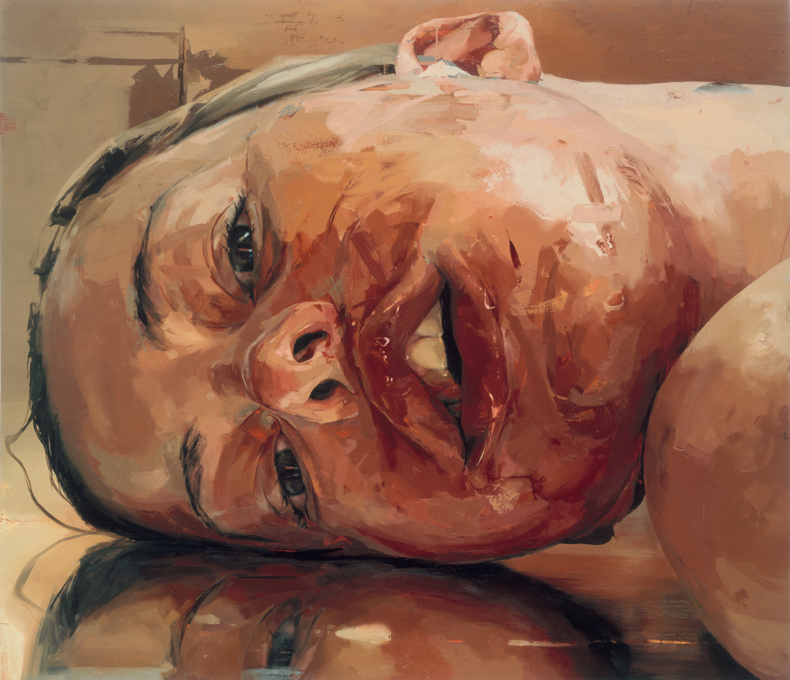
Reverse (2002–03), Jenny Saville. Private collection. Courtesy Gagosian; © Jenny Saville; all rights reserved, DACS 2025
In this sense, Saville might be considered a conceptual artist. She rose to prominence among the Young British Artists (YBAs); five of her paintings were included in the notorious ‘Sensation’ exhibition at the Royal Academy of Arts in 1997, in which a number of bracing conceptual works, drawn from the collection of Charles Saatchi, drew 300,000 visitors and howls of outrage from the British media. As with the YBAs, controversy followed her work for a time: one of her Stare paintings (2004–05), for instance, was used by Manic Street Preachers as the cover of their album Journal for Plague Lovers (2009); some supermarkets stocked the album in a plain slipcase because it was considered a violent image. (In fact, it was based on an image of a boy with a birthmark that she’d found in a medical textbook.)
But her insistence on painting, particularly figurative painting, set her apart from many other YBAs, which in any case was little more than a media label. Her reference points were unglamorous: she had been inspired to enrol at the Glasgow School of Art by the group of figurative painters that were there shortly before her – the New Glasgow Boys, Steven Campbell, Ken Currie, Peter Howson and Adrian Wiszniewski. She was also under the influence of the School of London, particularly Francis Bacon, Lucian Freud and Frank Auerbach. The attention she paid to these artists was nothing short of forensic: she pored over their drawing, brushwork and the kind of paint they used. She was fascinated by Auerbach’s obsessiveness – the models that he would return to over and over and the way he would remove all the paint from a painting and start again the next day, repeatedly building it up and scraping it away. And the violence of Bacon’s work – his idea of humans as animals, their bodies bursting out of the frame – left a clear trace on works such as Reverse. It’s fascinating to compare Reverse with Suspension, which Saville painted around the same time: their palette and composition are remarkably similar, but one is a human face and the other is a bloody porcine mass.
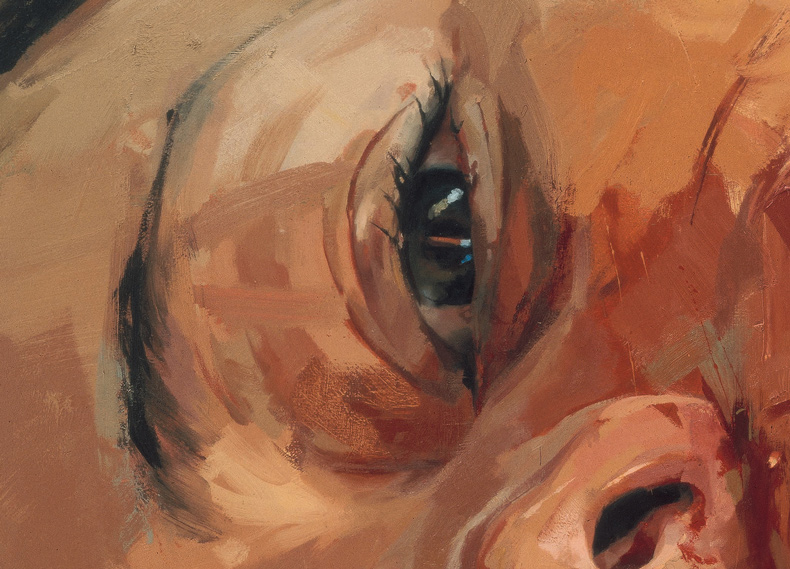
Detail from Reverse (2002–03) by Jenny Saville. Private collection. Courtesy Gagosian; © Jenny Saville; all rights reserved, DACS 2025
Some of her other reference points were even more unfashionable than modern figurative painters. As a teenager, she had spent time in Venice soaking up the influence of Titian, Rubens and Rembrandt. She had looked deeply at Rubens’s sketches, his fine details and his brushwork; she’d studied Titian’s Assumption of the Virgin (1516–18) at the Frari. (These interests were not fleeting; in 2015 she curated a show at the Royal Academy about Rubens’s legacy and, in 2022, when Titian’s Assumption was being restored, she climbed up the scaffolding to look at it up close.) Around the time she painted Reverse, she was living mostly in Palermo, looking at the Old Masters.
But Saville had no interest in imitation; she didn’t so much copy her progenitors as draw on their energy. Where the New Glasgow Boys had used the life room at the Glasgow School, Saville chose not to work from life; she made photography her primary source and has continued to paint from photos throughout her career. She would take hundreds of shots, not only of herself or other people but all sorts of things: road markings, signs, graffiti. She’s always been a scavenger of images and working from photographs allowed her to be bold and unexpected in her compositions. Reverse is a perfect example. With its strange orientation, its subject’s face pressed up against a floor, it could only have been made from a photograph – there’s no way she could have done it while looking in the mirror.
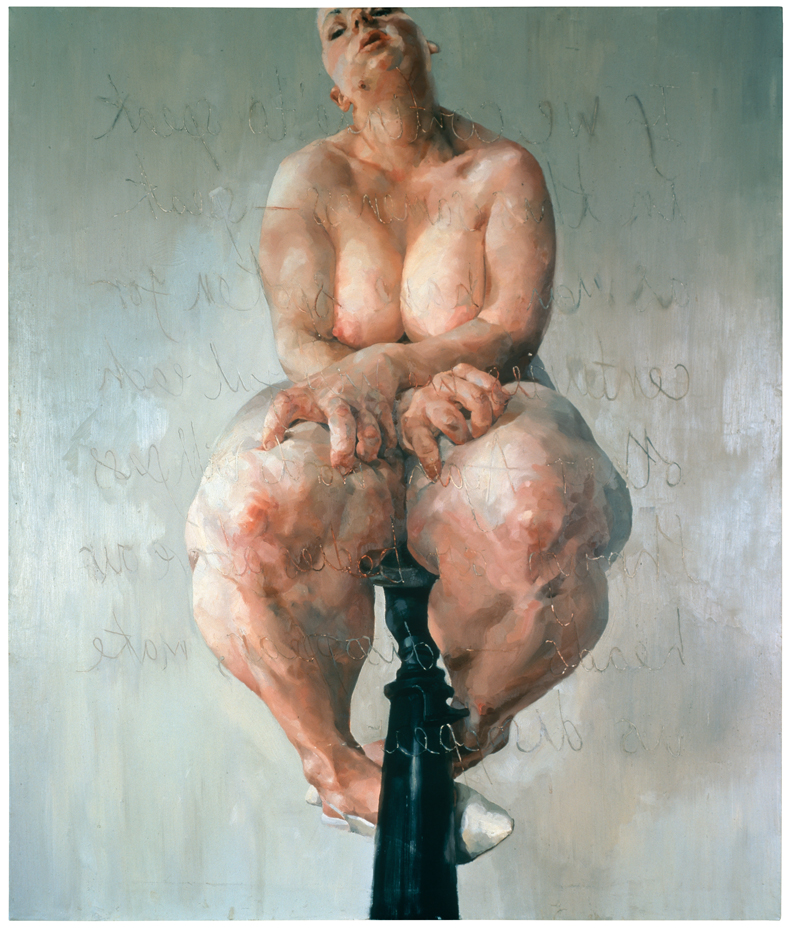
Propped (1992), Jenny Saville. Private collection. Courtesy Gagosian; © Jenny Saville; all rights reserved, DACS 2025
There is a reflective surface in Reverse, however. Saville had also used a mirror to make Propped (1992), one of the most distorted works she’s ever based on her own body, which she had shown to immediate acclaim at the Glasgow School of Art. A reflection of text written by the French language theorist and feminist philosopher Luce Irigaray shimmers faintly over the central figure. In Reverse she uses the mirror in a different way. It may have been informed by the work she had done in the mid ’90s with the fashion photographer Glen Luchford, who took shots of her face squashed against plates, glass and other surfaces. All self-portraits are reflections in a sense; Freud made a whole range of self-portraits that he called Reflection. But Saville incorporates the reflection into the painting. This gives Reverse a certain dynamism – as does the painting’s unusual orientation, which speaks to her longstanding interest in inversion, on occasion turning her canvas upside down to work on. There’s a physicality to her work, and a performative aspect; in Reverse, this comes not just from the brushstrokes but from her contact with the floor. Though she didn’t necessarily paint it while on the floor herself, she had intermittently been painting on the floor as early as 1999, when she made Hyphen – her well-known painting of two heads, based on her own and her sister’s, that appear almost to belong to a single person – partly using this technique. Willem de Kooning, a major influence on Saville, often worked on the floor, mining its possibilities for a different kind of mark-making.
The impression of vividness and energy in Reverse is heightened by the painting’s colour scheme. Her early nudes are characterised by cool palettes and, though Reverse wasn’t her first painting to use warmer tones – Figure 11.23 (1996–97), for example, is similar in palette – it feels particularly ‘hot’. (One critic pointed out that it looked as though she were painting with bodily fluids.) She made the painting for an exhibition she called ‘Migrants’, which opened at Gagosian in New York in 2003. Her first solo show at the gallery, ‘Territories’ in 1999, had been more concerned with representing her own body; ‘Migrants’ marked a move to a broader range of imagery. The trauma and violence of the news media, with all its death, disease, deformity and bodily horror, began to bleed into her work.
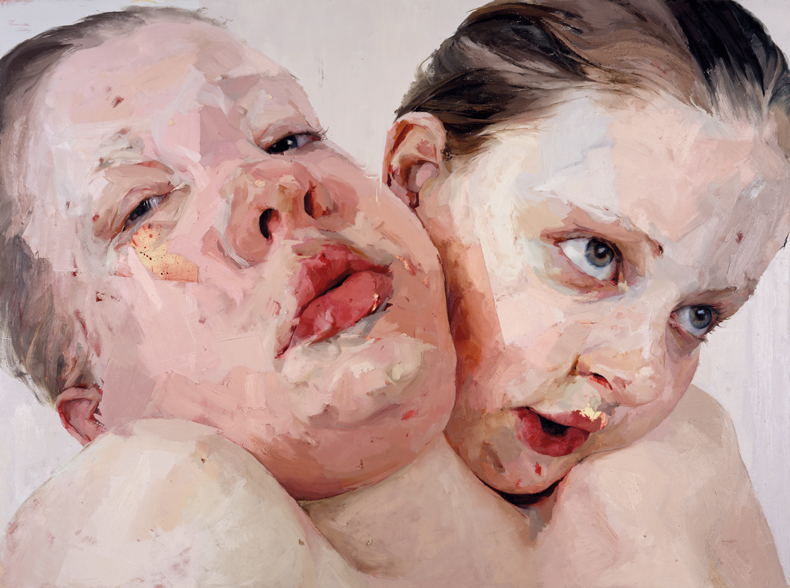
Hyphen (1999), Jenny Saville. Private collection. Courtesy Gagosian; © Jenny Saville; all rights reserved, DACS 2025
The show comprised six canvases, including Reverse. The art historian Linda Nochlin wrote the catalogue, describing Saville as ‘the most interesting and exciting painter of our times’ – which gives a sense of Saville’s stature in the art world even then. As classical or old-fashioned as her references were, it was her choice of themes and her post-painterly treatment of them that won her consistent acclaim. Her interest in depicting psychic and physical damage struck a chord in the wake of 9/11, but the way she captured this varied in intriguing ways: compare Reverse with Pause, which she made in the same year, also for ‘Migrants’, and based on a newspaper image of a woman staggering away from a bomb blast, her clothes torn from her body.
Reverse is more ambiguous. It’s sumptuous and in some ways seductive and beautiful, but also willing to undercut or even attack its own beauty. It’s sexually provocative, with the pouting lips and the glistening teeth, and almost overblown – but also very still, reflective in both senses of the word. One of her recent works, Tilt (2024), seems to revisit the orientation, composition and colours of Reverse; perhaps this is an indicator of the painting’s troubling power.
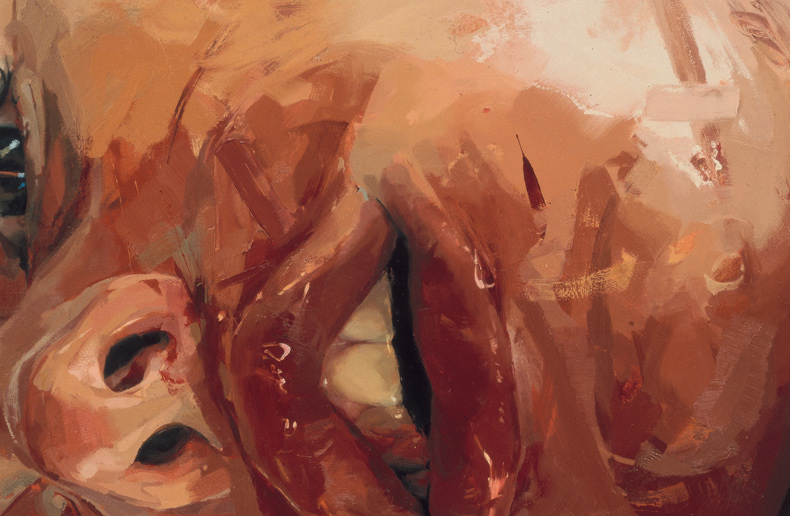
Detail from Reverse (2002–03) by Jenny Saville. Private collection. Courtesy Gagosian; © Jenny Saville; all rights reserved, DACS 2025
All great artists have their lasting images. Reverse, along with Propped, is the painting that inspired Saatchi to acquire as much of her work as possible in the first place. There’s something about how her use of paint evokes Rubens and Bacon and Freud all at once while channelling her own remarkable sensibilities. It is grotesque and it is sublime; it is painting as an act of pure energy.
This only really comes across in an exhibition context; reproductions in catalogues or on screens can never convey that sort of dynamism. So it’s extraordinary that the show at the National Portrait Gallery is her first major museum exhibition in the UK. Saville has influenced a wide range of creative figures, from painters such as Nathaniel Mary Quinn to the novelist and former fashion designer Douglas Stuart, who has cited Saville’s graduate show as a significant moment in his own artistic development. She has been more feted in Italy: in 2021 her work was exhibited in five venues around Florence, with her drawing Pietà I (2019–21) shown alongside Michelangelo’s Deposition (1547–55) in the Duomo. Her mastery of bodies is similar in some ways to his – that ability to twist, contort and combine cruelty and mercy. She has that rare dual gift: the eye of an art historian and the verve of a great artist.
As told to Arjun Sajip.
Sarah Howgate is senior curator of contemporary collections at the National Portrait Gallery in London.
‘Jenny Saville: The Anatomy of Painting’ is at the National Portrait Gallery, London, from 20 June–7 September.
From the June 2025 issue of Apollo. Preview and subscribe here.














![Masterpiece [Re]discovery 2022. Photo: Ben Fisher Photography, courtesy of Masterpiece London](http://zephr.apollo-magazine.com/wp-content/uploads/2022/07/MPL2022_4263.jpg)
‘Like landscape, his objects seem to breathe’: Gordon Baldwin (1932–2025)